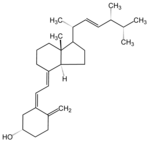Trivedi DP, Doll R, Khaw KT. Effect of four monthly oral vitamin D3 (cholecaciferol) supplementation on fractures and mortality in men and women living in the community: randomised double blind controlled trial. BMJ 2003;326:469-472.
* PRACTICE RECOMMENDATIONS
Vitamin D3 (or its physiologic equivalent, ergocalciferol), administered at a dose of 100,000 IU every 4 months for 5 years, is effective for primary prevention of fractures in the active elderly aged 65 to 85 years.
This treatment regimen has no effect on cardiovascular, cancer, or all-cause mortality. Despite a seemingly large dose averaging 800 IU per day, this regimen is a safe, cheap (<$2 per year), and effective therapy for primary prevention of fractures.
* BACKGROUND
Previous studies have shown that daily supplementation with vitamin D3 (800 IU) and calcium decreases the incidence of fractures; however, conflicting data exist as to whether vitamin D3 alone has the same effect. Observational studies suggest that vitamin D may increase the incidence of cancer and cardiovascular disease.
This study compares fracture risk, self-reported health and falls, incidence of cardiovascular disease and cancer, and mortality by cause for patients taking 100,000 IU of vitamin D3 orally every 4 months, compared with patients taking placebo.
* POPULATION STUDIED
This British study invited 9582 doctors from the Clinical Trials Studies Unit in Oxford and 1538 patients from a general practice in Ipswich, Suffolk, aged 65 to 85 years, to participate.
Patients were excluded if they were already taking vitamin D or had contraindications to vitamin D. Of all invited people, 2037 men and 649 women were eligible and agreed to participate.
No statistical tests were performed on the characteristics of these patients, though the average age (75 years), smoking, activity, calcium intake, steroid use, hormone replacement therapy, and alcohol intake of the patients were similar in the 2 groups. Race was not reported. Nearly 90% of patients reported being active or moderately active.
* STUDY DESIGN AND VALIDITY
After age, sex, and patient/physician stratification, subjects were randomly assigned to receive identical-appearing pills of vitamin D3 (100,000 IU) or placebo, which were mailed to them every 4 months for 5 years. Patients mailed back a card to confirm compliance and to report health and falls.
Analysis was by intention-to-treat. Crude outcome rates were reported, and Cox regression was used to calculate age-adjusted risk for fracture, cardiovascular disease and cancer, self-reported health and falls, and mortality by cause.
Patients, clinicians, and researchers were blinded to the treatment. Seventy-seven percent of patients were followed for the entire 5 years of the study. Randomization was double-blinded, and the researchers enrolling patients were not aware of the group to which the patient would be assigned (allocation was concealed).
The methodology of the study was sound. Strengths: large sample size, reasonable follow-up period, use of mortality registries for completeness, high compliance, and intention-to-treat analysis. Weaknesses were few: lack of information on race, no report of adverse effects, and lack of power calculations.
* OUTCOMES MEASURED
The primary outcome was any fracture as assessed by self-report or death certificate. Secondary outcomes included self-reported health and falls, cardiovascular and cancer incidence and mortality, and all-cause mortality.
* RESULTS
Compliance was similar among the physician and patient groups and between the placebo and vitamin D groups; fracture rates were similar among the physician and patient groups. Average calcium intake was similar.
The 5-year overall, age-adjusted fracture risk was lower for the patients receiving vitamin D (relative risk [RR]=0.78; 95% confidence interval [CI]=0.61-0.99; number needed to treat [NNT] for 5 years=44). Important fractures were also significantly lower--that is, those occurring at the hip, wrist, forearm, or vertebrae (RR=0.67; 95% CI=0.48-0.93; NNT for 5 years=49).
In an analysis by gender, women had a larger decrease in fracture risk at any site (RR=0.68; 95% CI, 0.46-1.01; NNT for 5 years=20). The difference for men was not statistically significant, but the study may not have enrolled enough men to find a difference if one existed.
Hip fractures, a known cause of severe morbidity in the elderly, were not significantly lower in the treated group; again, the study was probably too small or too brief to find a difference if one existed.
With respect to secondary outcomes, the vitamin D group, compared with the placebo group, had no statistically significant difference in self-reported health and falls, or mortality from cardiovascular disease, cancer, or all causes.
Janelle Guirguis-Blake, MD, and Robert L. Phillips, MD, MSPH, Robert Graham Center Policy Studies in Family Practice and Primary Care, Washington, DC. E-mail: jg247@georgetown.edu.
COPYRIGHT 2003 Dowden Health Media, Inc.
COPYRIGHT 2003 Gale Group



